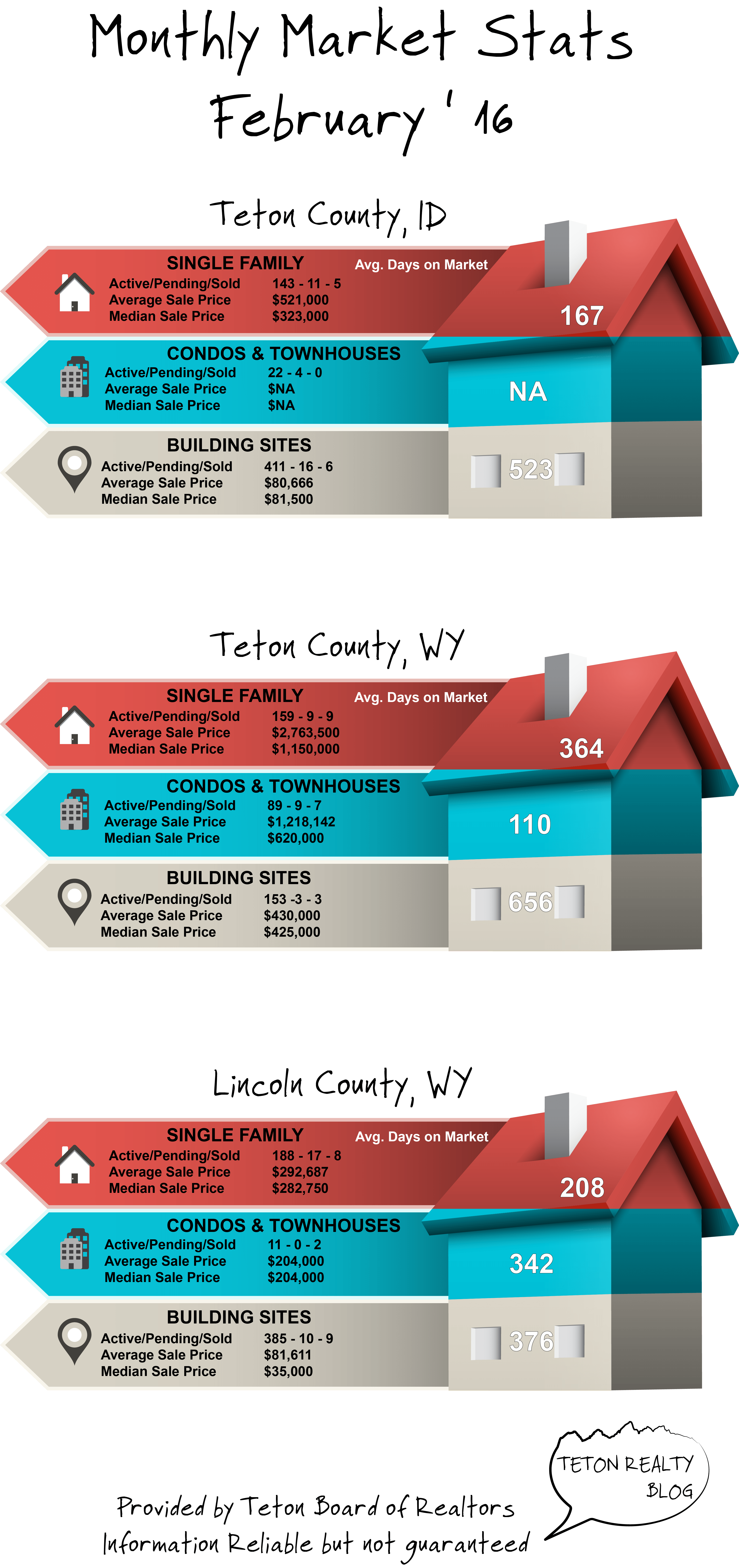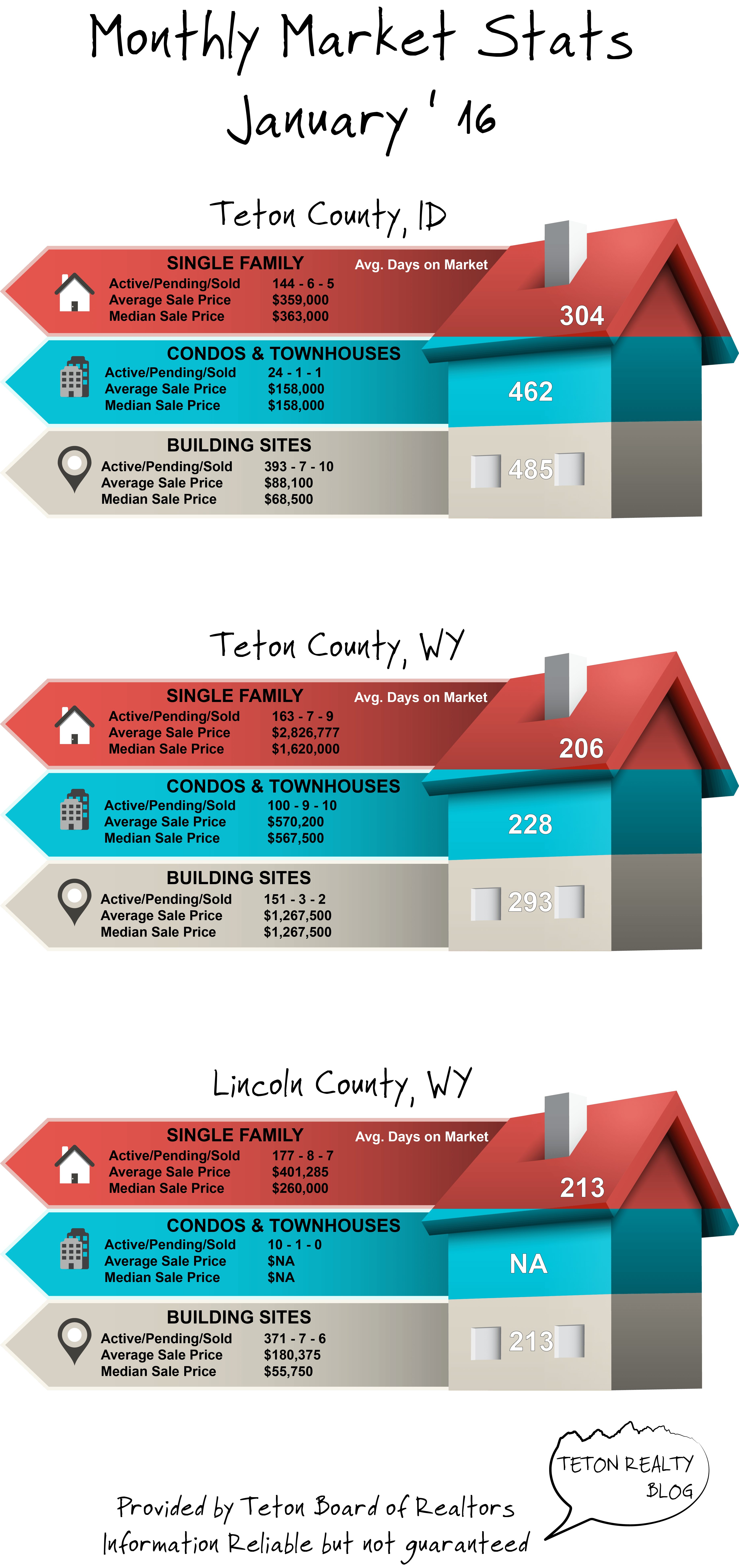
February ’16 Market Stats

Teton Region Real Estate Market Stats, Articles & News


Increasing Rent Rates, will it stop?
As most of us know, we are seeing major recovery in the real estate and rental market. Note I said recovery, not inflation – yet. Generally speaking, we are recovered to about 2005 levels. Not yet height of the market “boom” prices, but we are still recovering. There is quite a bit of buzz regarding new construction, homes to be built on spec, and even rental complex/apartment construction – mostly based on the assumption that the market will continue to grow and improve (hence the “spec” or “speculation”)
As we know, the key driving factor is demand. The availability of homes for sale in the affordable price range is minimal, and rental supply even worse. With that said, I agree that there is a fairly safe bet for investment potential.
The above said leads me to predictions for the question. My response is – I hope that is slows, or better yet, quickly recovers to reasonable degree, levels off, and stays on par with inflation. We need to remember that there is a fine balance between a return on an investment, and real world effects. The result of too much supply too quickly coupled with National ecenomic factors (which will always be in play) is still all too fresh in my mind. We must also remember who we are in Teton Valley. I believe we will always be the “quiet side of the Tetons” a family oriented community supported by our own tourism, and proximity to Jackson and Idaho Falls. We cannot directly compete with Jackson, and we should not. We have a niche here with semi-resort real estate prices that is still an attractive place for an investor, and/or a resident.
In my opinion, we are competing for a population and commerce, but more so with areas like Alpine, WY or Rexburg, ID. If prices here become unobtainable for most (such as Jackson) the vast majority of those who support us will not be able to afford to live here. This is particularly true with rental rates. In times where supply is dangerously low, the sky’s the limit. This is a perfect opportunity for investors and owners to take advantage of the market – as they should. However, I do caution our community. We need to remember that we must work together to support each other. We still have shoulder seasons. If the cost of living becomes too high for a meal, a service, or a rental, our community will look for alternatives they can afford.
So, here’s to continued growth, recovery, and profitability – in responsible, high quality, Teton Valley Style!
I’m glad you mentioned owner finance and lease to own in the same question. In a way, they’re the same thing. a summary of each;
-Owner finance is possession upon closing, usually in the form of a deed of trust. This works the same as getting a loan and buying a home, except the owner collects the payments. Usually the owner will collect payments through a third party such as a title company and a long term escrow. This way, your insurance and taxes are typically included in the mortgage payment to protect the seller from a disaster or tax foreclosure.
-A lease to own is not considered possession upon closing, but exactly how it reads, leasing until either obtaining finance by the bank, the owner, or cash at the end of the lease term. typically a portion of the lease payments would apply to the purchase price in this event.
Now, why aren’t they very popular? I think the best way to understand this is pros and cons of each. Not only that, but there are pros and cons for each the seller and the buyer, which are sometimes conflicting. In the owner finance situation, the buyer has an opportunity to recover poor credit, and purchase a home today at (presumably) a lower price. On the conflicting inside, the seller is (presumably) selling the home for a lower price today to a buyer with potential credit problems and not receiving a full cash payment to invest elsewhere. Of course in return for this, the seller will be making a return on the interest rate. That interest rate must be sufficient to cover a higher return than the seller would make investing the full cash investment elsewhere today. This might sound weighted towards disadvantages for the seller only, but there are other disadvantages for the buyer. The biggest disadvantage to the buyer in my opinion is the lack of inventory. We are already in short supply, and even shorter, approaching nonexistent supply for owner finance. That means the buyer has very little to choose from, and may be stuck with a home they really don’t want, or can’t afford just to make the terms of the owner finance work. The buyer must determine if this is the only route, even after credit recovery, the buyer can take.
With regards to the lease to own situation, this is very similar. However, the buyer may not have credit issues, but simply wants to learn about the area before moving into a purchase. Though the risk might be minimized on the credit aspect for the seller, the other terms remain the same. Even worse, they don’t have the initial cash deposit they would with the owner finance, which would come usually in full payment after the end of the lease term. Moreover, the same inventory and choice issues remain the same for the buyer. The buyer is looking for a home they will enjoy leasing, and living in, all in one. Where neither opportunities are common, this drastically reduces the availability in the number of homes to choose from, both for rent and for sale. In this circumstance I would advise the buyer to find a more affordable rental option, and keep their options wide open for a purchase after their lease is up and they have determined they want to live in the area.
On a final note, market conditions can drastically change the amount of inventory. With the two real estate markets in recent history though, it has not. In the wake of the downturn, a number of sellers had mortgages that far exceeded market value. They did not have the option to owner finance because even the initial or final payment would not recover their initial investment. Remember, in most cases an owner can only owner finance if they own the real estate out right. In today’s recovering real estate market with low inventory and supply, it simply does not make sense for a seller who can easily sell their home at market rates today, without the hassle of going through the owner finance situation. Since other markets are also doing reasonably well, the cash they would receive on a full purchase sale could be reinvested at a substantial return.
There are circumstances I did not touch on in this article. If you find yourself in this situation as a buyer or seller, and would like any free advice, don’t hesitate. Also remember to keep your eye on the Teton Valley Realty blog for other information on the topics above!